The Long-range Camera Market is estimated to be valued at USD 10.3 billion in 2025 and is projected to reach USD 21.6 billion by 2035, registering a compound annual growth rate (CAGR) of 7.7% over the forecast period.
The Long-range Camera market is witnessing significant growth, driven by increasing demand for advanced surveillance, defense, and industrial monitoring solutions. Adoption is being supported by the need for high-resolution imaging over extended distances in applications such as border security, airborne surveillance, critical infrastructure monitoring, and environmental observation. Technological advancements in sensor design, optics, and image processing are enabling improved detection, recognition, and tracking capabilities, even under challenging environmental conditions.
Integration of AI-based analytics and real-time data processing is enhancing operational efficiency and situational awareness. Growing investments in defense modernization, unmanned aerial systems, and intelligent monitoring systems are further accelerating market expansion.
Market growth is also influenced by the rising need for multi-platform adaptability and scalable solutions that can meet diverse application requirements As organizations increasingly prioritize real-time monitoring, risk mitigation, and operational intelligence, the Long-range Camera market is poised for sustained growth, with innovations in sensor technologies, software integration, and system interoperability shaping future opportunities.
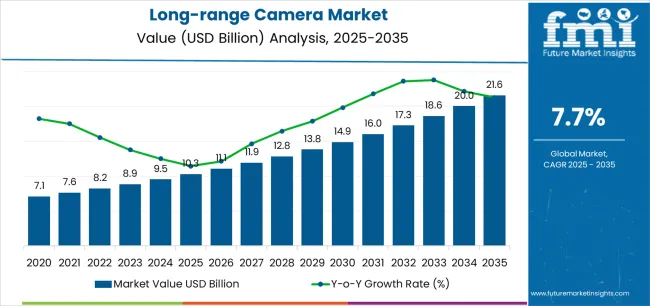
| Metric | Value |
|---|---|
| Long-range Camera Market Estimated Value in (2025 E) | USD 10.3 billion |
| Long-range Camera Market Forecast Value in (2035 F) | USD 21.6 billion |
| Forecast CAGR (2025 to 2035) | 7.7% |
The market is segmented by Wavelength, Platform, Focal Length, Camera Installations, and Application and region. By Wavelength, the market is divided into Short Wave Infrared (SWIR), Medium Wave Infrared (MWIR), Long Wave Infrared (LWIR), and Others. In terms of Platform, the market is classified into Airborne, Land, and Naval. Based on Focal Length, the market is segmented into 200 - 400 Mm, Below 200 Mm, 400 - 800 Mm, and Above 800 Mm. By Camera Installations, the market is divided into Fixed Installation, Portable, and Platform-Mounted. By Application, the market is segmented into Designated Marksman Target Spotting & Range Detection, Intelligence, Surveillance, Target Acquisition, And Reconnaissance (ISTAR), Command And Control, Long Range Shooting Sports Spotting & Range Detection, Counter-Unmanned Aerial Systems Operations, Forest & Wildlife Protection, Inspection, Surveying & Mapping, Disaster Monitoring, Aerial Photography & Cinematography, and Others. Regionally, the market is classified into North America, Latin America, Western Europe, Eastern Europe, Balkan & Baltic Countries, Russia & Belarus, Central Asia, East Asia, South Asia & Pacific, and the Middle East & Africa.
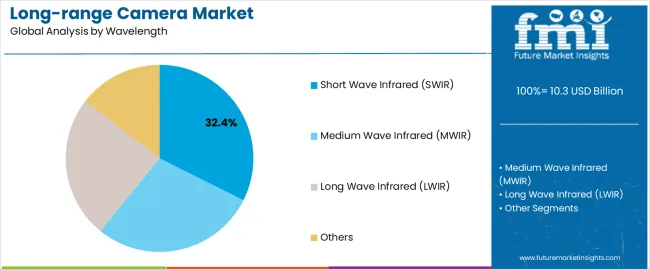
The short wave infrared (SWIR) wavelength segment is projected to hold 32.4% of the Long-range Camera market revenue in 2025, establishing it as the leading wavelength category. Growth in this segment is being driven by the superior ability of SWIR sensors to detect and capture high-resolution images in low-light, foggy, and obscured conditions, which is critical for surveillance, security, and industrial monitoring applications.
SWIR cameras provide enhanced target recognition, material differentiation, and penetration through atmospheric obscurants compared to traditional visible and near-infrared cameras. The ability to integrate SWIR sensors with AI-driven analytics and long-range optics further improves operational efficiency and decision-making capabilities.
Rising adoption across defense, aerospace, and industrial sectors, coupled with advancements in compact, high-sensitivity SWIR detectors, has reinforced market leadership As the demand for reliable imaging solutions in challenging environmental and operational conditions continues to rise, SWIR wavelength cameras are expected to maintain their dominant market position, supported by technological innovation and expanding application scope.
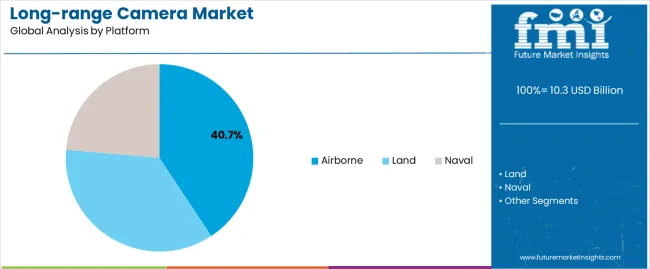
The airborne platform segment is expected to account for 40.7% of the Long-range Camera market revenue in 2025, making it the leading platform category. Growth in this segment is being driven by the increasing use of unmanned aerial vehicles (UAVs), helicopters, and aircraft for surveillance, reconnaissance, border security, and environmental monitoring applications. Airborne platforms enable extensive coverage over large areas, combined with high-resolution imaging capabilities, enhancing situational awareness and operational efficiency.
The integration of long-range cameras with stabilization systems, GPS, and AI-based image processing allows for real-time monitoring and actionable intelligence gathering. Rising investments in defense modernization, disaster management, and smart city surveillance initiatives are further supporting adoption.
Airborne deployment provides flexibility, rapid response capability, and scalability across diverse operational environments, reinforcing its market dominance As demand for long-range situational awareness and surveillance continues to grow, airborne platforms are expected to remain the primary driver of market expansion, supported by advancements in imaging, sensor integration, and unmanned flight technologies.
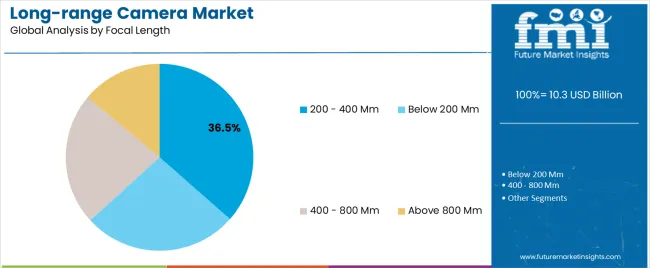
The 200 - 400 mm focal length segment is projected to hold 36.5% of the Long-range Camera market revenue in 2025, establishing it as the leading focal length category. Its growth is driven by the ability to achieve optimal magnification and resolution for medium- to long-distance surveillance and monitoring applications.
This focal length range provides a balance between portability, field of view, and image clarity, making it suitable for airborne, ground, and fixed-point monitoring systems. Long-range cameras with 200 - 400 mm focal lengths are widely adopted in defense, critical infrastructure monitoring, industrial inspections, and border surveillance due to their versatility and reliability.
Integration with high-resolution sensors and advanced image stabilization technologies enables precise target identification and tracking over extended distances As the need for accurate, high-resolution imaging for situational awareness and operational efficiency continues to rise, the 200 - 400 mm focal length segment is expected to maintain its leading position, driven by the combination of performance, adaptability, and wide applicability across various sectors.
Digitalization and the adoption of artificial intelligence have revolutionized traditional business models. This has fostered innovation and the need to have a vigilant eye on things to monitor tasks, making it more effective across sectors. Some factors propelling the growth of the market are
Even though long-range cameras have a multitude of applications, various factors are slowing down the market. Some of them are
Advanced technology and superior performance requirements for operational purposes in the land segment have held the highest share in the ongoing surge for long-range cameras. The land segment to secure its market with a CAGR of 7.9% through 2035.
| Attributes | Details |
|---|---|
| Platform | Land |
| CAGR (2025 to 2035) | 7.9% |
In land applications, long-range cameras play a critical role in serving and paying attention to warfare personnel. They are strategically deployed in training centers, vehicles, surveillance posts, and other sensitive areas. Thus, the market is acquiring traction globally for strategies, security, and surveillance for optimized tracking through terrain bases.
By wavelength, the long wave infrared (LWIR) segment showcases reasonable upscale in the market with a CAGR of 7.7% from 2025 to 2035.
| Attributes | Details |
|---|---|
| Wavelength | Long Wave Infrared (LWIR) |
| CAGR (2025 to 2035) | 7.7% |
The growth of the long-wave infrared wavelength is attributed to its increasing utility in homeland security, surveillance, object detection, and other scientific and industrial applications. As this wavelength can be used in complete darkness, it can be used for animal mappings and surveys. This increases its demand in the forest and wildlife welfare sectors.
LWIR sensors and imaging systems are generally more affordable compared to MWIR systems. This makes them more accessible for various applications, including consumer products like thermal cameras.
Countries like Australia and New Zealand, China, the United States, Germany, and Japan are expanding broadly in the long-range camera industry.
| Countries | CAGR from 2025 to 2035 |
|---|---|
| South Korea | 10.0% |
| Japan | 9.7% |
| United Kingdom | 9.2% |
| China | 8.8% |
| United States | 8.4% |
Long-range cameras in South Korea are used for various applications, from military surveillance to traffic management. With a CAGR of 10.0%, the South Korea long-range camera market is projected through 2035.
Law enforcement agencies use these cameras to monitor high-crime areas and deter criminal activities. This leads to significant market growth as identifying suspects and investigating crimes becomes easier.
Disruption from neighboring countries necessitates the adoption of high-tech equipment like long-range cameras for border security purposes.
Japan, with a CAGR of 9.7%, pushes growth in the long-range camera market. These cameras monitor traffic flow and detect accidents or incidents on highways and major roads.
Rapid infrastructure development and industrialization in Japan have been significantly influenced by the increased demand for infrared cameras in the manufacturing and construction sectors. Demand in Japan is also boosted by increasing expenditure on defense and security.
The market in the United States is expected to reach a CAGR of 9.2% from 2025 to 2035. With ongoing developments in infrastructure, the market is going to reach the skies.
Rising urbanization in the United Kingdom has LED to the development of modern commercial spaces, both in the public and private domains. This has automatically generated substantial demand for these cameras in the United Kingdom for surveillance and safety.
Traffic management has become a major concern in China. With a CAGR of 8.8%, the China long-range camera market is in a steady growth phase.
Growing integration of IoT and AI in long-range cameras has made them more efficient and effective. This has attracted many renowned companies in China to invest in this market and introduce new advances.
Due to high-security concerns in China, the government has been investing heavily in security and surveillance infrastructure in the country. This has created a huge demand for these cameras in China.
The United States monitors high-risk areas such as airports, government buildings, and critical infrastructure and detects potential threats from a distance through the use of these cameras. Thus, the United States market is experiencing continuous growth with a CAGR of 8.4% through 2035.
Industries such as oil and gas use long-range cameras to monitor operations, ensure worker safety, and detect potential hazards from a distance. These cameras are also used to monitor traffic flow on highways and major roads in the United States.
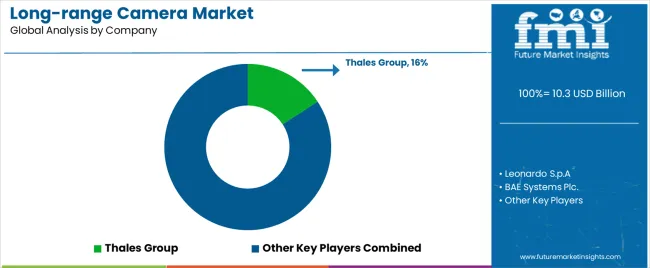
Top companies are investing heavily in research and development to improve camera quality, increase range, and add new features to meet the growing demand for long-range cameras. Sony has been actively developing its Alpha series of mirrorless cameras with high-quality zoom lenses and advanced autofocus systems.
Canon has recently launched its EOS R5 and R6 mirrorless cameras with impressive image quality and long-range capabilities. Nikon is also focusing on expanding its Z series mirrorless camera lineup with high-performance lenses and innovative features.
Panasonic is developing its Lumix S series of full-frame mirrorless cameras with advanced autofocus and image stabilization systems.
Recent Advancements
The global long-range camera market is estimated to be valued at USD 10.3 billion in 2025.
The market size for the long-range camera market is projected to reach USD 21.6 billion by 2035.
The long-range camera market is expected to grow at a 7.7% CAGR between 2025 and 2035.
The key product types in long-range camera market are short wave infrared (swir), medium wave infrared (mwir), long wave infrared (lwir) and others.
In terms of platform, airborne segment to command 40.7% share in the long-range camera market in 2025.






Full Research Suite comprises of:
Market outlook & trends analysis
Interviews & case studies
Strategic recommendations
Vendor profiles & capabilities analysis
5-year forecasts
8 regions and 60+ country-level data splits
Market segment data splits
12 months of continuous data updates
DELIVERED AS:
PDF EXCEL ONLINE
Camera Lens Market Size and Share Forecast Outlook 2025 to 2035
Camera Module Market Size and Share Forecast Outlook 2025 to 2035
Camera Technology Market Analysis – Trends & Forecast 2025 to 2035
Camera Accessories Market Trends - Growth & Forecast 2024 to 2034
Camera Case Market Trends & Industry Growth Forecast 2024-2034
IP Camera Market Trends – Growth, Demand & Forecast 2025 to 2035
3D Camera Market Growth – Trends & Forecast 2025 to 2035
TDI Camera Market Growth - Trends & Forecast 2025 to 2035
Intracameral Antibiotics Market Analysis - Size, Share, and Forecast Outlook 2025 to 2035
CMOS Camera Market Size and Share Forecast Outlook 2025 to 2035
GigE Camera Market Size and Share Forecast Outlook 2025 to 2035
CCTV Camera Market Demand & Sustainability Trends 2025-2035
Smart Camera Market Analysis – Size, Share & Forecast 2025 to 2035
Drain Camera Market
InGaAs Cameras Market by Technology, Scanning Type, Industry & Region Forecast till 2035
Action Camera Market
Mobile Camera Module Market
Network Cameras and Video Analytics Market Analysis – Trends & Forecast 2025 to 2035
Security Cameras (IR Illuminator) Market Size and Share Forecast Outlook 2025 to 2035
Aircraft Cameras Market Size and Share Forecast Outlook 2025 to 2035

Thank you!
You will receive an email from our Business Development Manager. Please be sure to check your SPAM/JUNK folder too.
Chat With
MaRIA